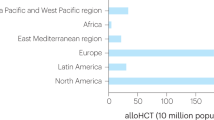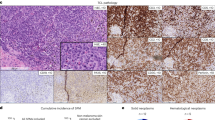Abstract
Factors relevant to finding a suitable unrelated donor and barriers to effective transplant utilization are incompletely understood. Among a consecutive series of unrelated searches (n=531), an 8/8 HLA-A, -B, -C and -DRB1-matched unrelated donor was available for 289 (54%) patients, 7/8 for 159 (30%) and no donor for 83 (16%). Patients of Caucasian race (P<0.0001) were more likely to find a donor. Younger age (P=0.01), Caucasian race (P=0.03), lower CIBMTR (Center for International Blood and Marrow Transplantation Research) risk (P=0.005), and 8/8 HLA matching (P=0.005) were associated with higher odds of reaching hematopoietic cell transplantation (HCT). In a univariate analysis of OS, finding a donor was associated with hazard ratio (HR) of 0.85 (95% CI 0.63–1.2), P=0.31. Karnofsky performance status (KPS) accounted for interaction between having a donor and survival. Patients with KPS 90–100 and a donor had significantly reduced hazard for death (HR 0.59, 95% CI 0.38–0.90, P=0.02). These data provide estimates of the probability to find an unrelated donor in the era of high-resolution HLA typing, and identify potentially modifiable barriers to reaching HCT. Further efforts are needed to enhance effective donor identification and transplant utilization, particularly in non-Caucasian ethnic groups.
This is a preview of subscription content, access via your institution
Access options
Subscribe to this journal
Receive 12 print issues and online access
$259.00 per year
only $21.58 per issue
Buy this article
- Purchase on Springer Link
- Instant access to full article PDF
Prices may be subject to local taxes which are calculated during checkout
Similar content being viewed by others
References
Karanes C, Nelson GO, Chitphakdithai P, Agura E, Ballen KK, Bolan CD et al. Twenty years of unrelated donor hematopoietic cell transplantation for adult recipients facilitated by the National Marrow Donor Program. Biol Blood Marrow Transplant 2008; 14 (9 Suppl): 8–15.
Lee SJ, Klein J, Haagenson M, Baxter-Lowe LA, Confer DL, Eapen M et al. High-resolution donor-recipient HLA matching contributes to the success of unrelated donor marrow transplantation. Blood 2007; 110: 4576–4583.
Barker JN, Byam CE, Kernan NA, Lee SS, Hawke RM, Doshi KA et al. Availability of cord blood extends allogeneic hematopoietic stem cell transplant access to racial and ethnic minorities. Biol Blood Marrow Transplant 2010; 16: 1541–1548.
Brunstein CG, Fuchs EJ, Carter SL, Karanes C, Costa LJ, Wu J et al. Alternative donor transplantation after reduced intensity conditioning: results of parallel phase 2 trials using partially HLA-mismatched related bone marrow or unrelated double umbilical cord blood grafts. Blood 2011; 118: 282–288.
Luznik L, O'Donnell PV, Symons HJ, Chen AR, Leffell MS, Zahurak M et al. HLA-haploidentical bone marrow transplantation for hematologic malignancies using nonmyeloablative conditioning and high-dose, posttransplantation cyclophosphamide. Biol Blood Marrow Transplant 2008; 14: 641–650.
Brunstein CG, Miller JS, Cao Q, McKenna DH, Hippen KL, Curtsinger J et al. Infusion of ex vivo expanded T regulatory cells in adults transplanted with umbilical cord blood: safety profile and detection kinetics. Blood 2011; 117: 1061–1070.
Di Ianni M, Falzetti F, Carotti A, Terenzi A, Del Papa B, Perruccio K et al. Immunoselection and clinical use of T regulatory cells in HLA-haploidentical stem cell transplantation. Best Pract Res Clin Haematol 2011; 24: 459–466.
Liu H, Rich ES, Godley L, Odenike O, Joseph L, Marino S et al. Reduced-intensity conditioning with combined haploidentical and cord blood transplantation results in rapid engraftment, low GVHD, and durable remissions. Blood 2011; 118: 6438–6445.
Delaney C, Heimfeld S, Brashem-Stein C, Voorhies H, Manger RL, Bernstein ID . Notch-mediated expansion of human cord blood progenitor cells capable of rapid myeloid reconstitution. Nat Med 2010; 16: 232–236.
Delaney M, Cutler CS, Haspel RL, Yeap BY, McAfee SL, Dey BR et al. High-resolution HLA matching in double-umbilical-cord-blood reduced-intensity transplantation in adults. Transfusion 2009; 49: 995–1002.
Frassoni F, Gualandi F, Podesta M, Raiola AM, Ibatici A, Piaggio G et al. Direct intrabone transplant of unrelated cord-blood cells in acute leukaemia: a phase I/II study. Lancet Oncol 2008; 9: 831–839.
Barker JN, Scaradavou A, Stevens CE . Combined effect of total nucleated cell dose and HLA match on transplantation outcome in 1061 cord blood recipients with hematologic malignancies. Blood 2010; 115: 1843–1849.
Shpall EJ, Quinones R, Giller R, Zeng C, Baron AE, Jones RB et al. Transplantation of ex vivo expanded cord blood. Biol Blood Marrow Transplant 2002; 8: 368–376.
Shpall EJ, Bollard CM, Brunstein C . Novel cord blood transplant therapies. Biol Blood Marrow Transplant 2011; 17 (1 Suppl): S39–S45.
Reisner Y, Hagin D, Martelli MF . Haploidentical hematopoietic transplantation: current status and future perspectives. Blood 2011; 118: 6006–6017.
Sorror ML, Maris MB, Storb R, Baron F, Sandmaier BM, Maloney DG et al. Hematopoietic cell transplantation (HCT)-specific comorbidity index: a new tool for risk assessment before allogeneic HCT. Blood 2005; 106: 2912–2919.
Artz AS . Comorbidity and beyond: pre-transplant clinical assessment. Bone Marrow Transplant 2005; 36: 473–474.
Artz AS, Pollyea DA, Kocherginsky M, Stock W, Rich E, Odenike O et al. Performance status and comorbidity predict transplant-related mortality after allogeneic hematopoietic cell transplantation. Biol Blood Marrow Transplant 2006; 12: 954–964.
Baker KS, Davies SM, Majhail NS, Hassebroek A, Klein JP, Ballen KK et al. Race and socioeconomic status influence outcomes of unrelated donor hematopoietic cell transplantation. Biol Blood Marrow Transplant 2009; 15: 1543–1554.
Baker KS, Loberiza FR, Yu H, Cairo MS, Bolwell BJ, Bujan-Boza WA et al. Outcome of ethnic minorities with acute or chronic leukemia treated with hematopoietic stem-cell transplantation in the United States. J Clin Oncol 2005; 23: 7032–7042.
Serna DS, Lee SJ, Zhang MJ, Baker S, Eapen M, Horowitz MM et al. Trends in survival rates after allogeneic hematopoietic stem-cell transplantation for acute and chronic leukemia by ethnicity in the United States and Canada. J Clin Oncol 2003; 21: 3754–3760.
Silla L, Fischer GB, Paz A, Daudt LE, Mitto I, Katz B et al. Patient socioeconomic status as a prognostic factor for allo-SCT. Bone Marrow Transplant 2009; 43: 571–577.
Wheatley K, Gray R . Commentary: Mendelian randomization--an update on its use to evaluate allogeneic stem cell transplantation in leukaemia. Int J Epidemiol 2004; 33: 15–17.
Author information
Authors and Affiliations
Corresponding author
Ethics declarations
Competing interests
The authors declare no conflict of interest.
Rights and permissions
About this article
Cite this article
Pidala, J., Kim, J., Schell, M. et al. Race/ethnicity affects the probability of finding an HLA-A, -B, -C and -DRB1 allele-matched unrelated donor and likelihood of subsequent transplant utilization. Bone Marrow Transplant 48, 346–350 (2013). https://doi.org/10.1038/bmt.2012.150
Received:
Revised:
Accepted:
Published:
Issue Date:
DOI: https://doi.org/10.1038/bmt.2012.150
Keywords
This article is cited by
-
Investigation of variables affecting the immunogenicity of blood group antigens using a calculation formula
Scientific Reports (2023)
-
Differential admixture, human leukocyte antigen diversity, and hematopoietic cell transplantation in Latin America: challenges and opportunities
Bone Marrow Transplantation (2020)
-
ATIR101 administered after T-cell-depleted haploidentical HSCT reduces NRM and improves overall survival in acute leukemia
Leukemia (2020)
-
Availability of HLA-allele-matched unrelated donors: estimation from haplotype frequency in the Japanese population
Bone Marrow Transplantation (2019)
-
Outcomes Following Allogeneic Stem Cell Transplantation Using Non-sibling Family Donors
Indian Journal of Hematology and Blood Transfusion (2019)



